
L4: CELLULAR RESPIRATION
Metabolism
It is the process by which the body changes food and drink into energy.
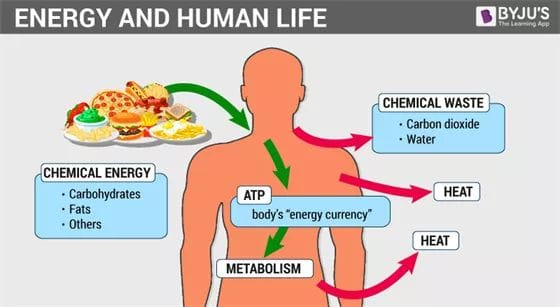
2 Major Parts of Metabolism
ANABOLISM - The part of metabolism that builds up larger molecules, producing new protoplasm or growth. The process by which the body utilizes the energy released by catabolism to synthesize complex molecules. These complex molecules are then utilized to form cellular structures that are formed from small and simple precursors that act as building blocks.
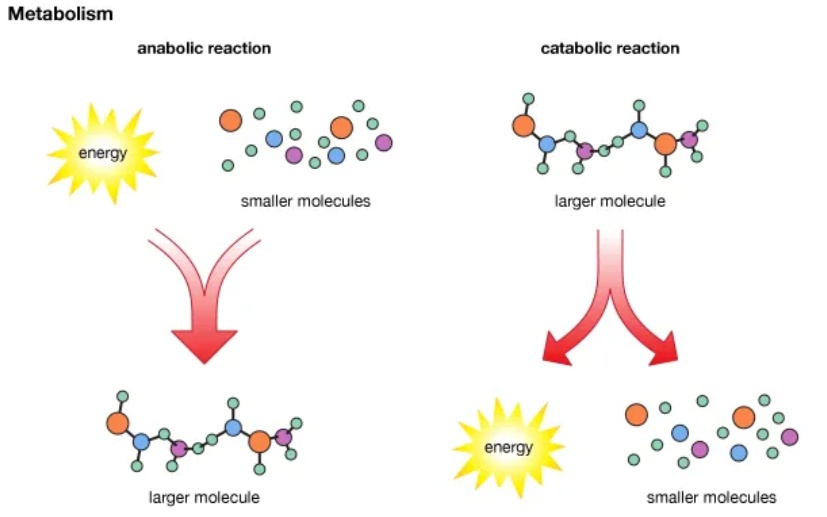
CATABOLISM - The breaking down of complex substances that release energy and the wearing up of cell protoplasm.
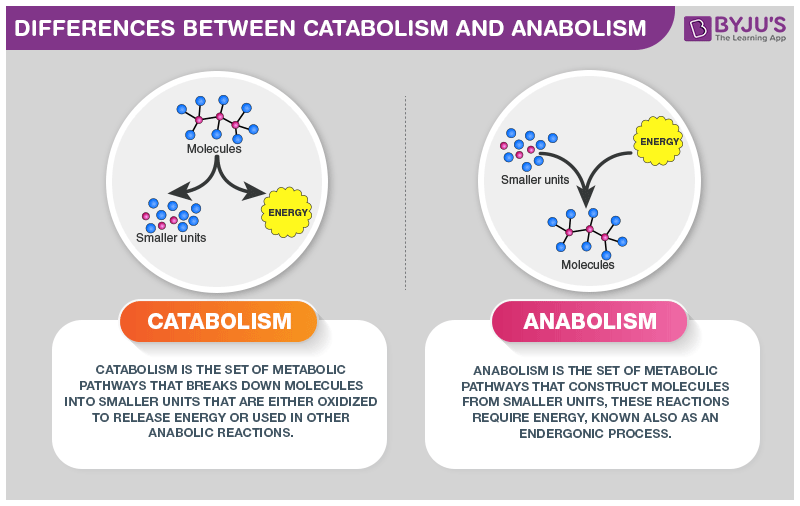
Cellular Respiration
The process of oxidizing food molecules like glucose, to carbon dioxide and water.
The process by which organisms combine oxygen with foodstuff molecules, diverting the chemical energy in these substances into life-sustaining activities and discarding, waste products, carbon dioxide, and water.
The term respiration often means breathing or simply “the process of inhaling and exhaling”. For clarity, cellular respiration refers to a series of enzymatic reactions that can occur in the presence or absence of oxygen and make energy available to the cell.

Life depends on energy.
Energy stored in food is converted to other forms of energy, according to the first law of thermodynamics: energy is neither created nor destroyed; it can only transform one form to another.
Energy is conserved and harnessed for cellular activities, while heat is dissipated to increase the random motion of molecules, conforming to the second law of thermodynamics. All objects in the universe tend to become disorderly.
Cells release and convert sugar molecules into ATP, which is used to sustain life by cellular respiration, resulting in a continuous supply of ATP.
2 Types of Cellular Respiration
AEROBIC RESPIRATION - The process of cellular respiration that takes place in the presence of oxygen gas to produce energy from food. In this process, water and carbon dioxide are produced as end products.
It is a biological process in which food glucose is converted into energy in the presence of oxygen.
Glucose (C6H12O6) + Oxygen 6(O2) → Carbon-dioxide 6(CO2) + Water 6 (H2O) + Energy (ATP)
Energy is released by splitting the glucose molecules with the help of oxygen gas. The 2900 kJ of energy is released during the process of breaking the glucose molecule. In turn, this energy is used to produce ATP – Adenosine Triphosphate molecules used by the system for various purposes.
GLYCOLYSIS - the process in which glucose is broken down to produce energy.
It produces two molecules of pyruvate, ATP, NADH, and water. The process occurs in a cell’s cytoplasm and does not require oxygen.
The primary step of cellular respiration, which occurs in all organisms. Glycolysis is followed by the Krebs cycle during aerobic respiration. In the absence of oxygen, the cells make small amounts of ATP as glycolysis is followed by fermentation.
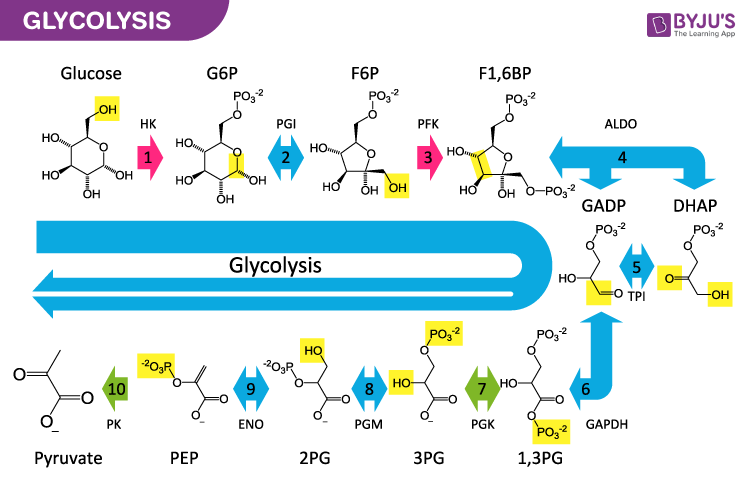
Anaerobic and releases energy from glucose in the cytoplasm of cells, allowing prokaryotes and eukaryotes to transport nutrients from the digestive system.
Glycolysis requires activation energy to begin, and two ATP is needed to start the reaction. The ATP phosphorylates glucose, energizing it to start the reaction. Four ATP and two NADH molecules are generated as a result of the reactions, resulting in a net gain of two ATP.
Glycolysis is the initial step in both aerobic and anaerobic respiration, occurring in the cytoplasmic fluid in an anaerobic condition. It involves the breakdown of glucose into two molecules of pyruvate(pyruvic acid/ three-carbon compound), with a net energy yield of two ATP molecules per glucose molecule. The remaining energy remains in the chemical bonds of pyruvate that must be further broken down.
Steps 1 to 3 - The glucose molecule is energized, using ATP.
Glucose is the first phosphorylated to glucose-6-phosphate (step 1), which is rearranged to form Fructose-6-phosphate (step 2) Another phosphate group is added to form fructose 1,6-diphosphateI (step 3). The cell invests two molecules of ATP in steps 1 and 3 to energize one glucose molecule and form fructose 1,6-bisphosphate, which is unstable and reactive.
Step 4 - Fructose 1,6-diphosphate
Converted into two molecules of glyceraldehyde 3-phosphate (PGAL) Since there are two molecules of PGAL produced, steps 5 to 9 occur twice per glucose molecule
Step 5 - Reduction of PGAL produces NADH This step is the first payoff step. PGAL donates a hydrogen atom and two electrons NAD+ (nicotinamide adenine dinucleotide), reducing it to NADH. NADH, an electron carrier, has a similar structure to NADPH except that it has one less phosphate group attached to ribose
Steps 6 to 9 - ATP and pyruvic acids are produced. A sequence of four chemical reactions completes the breakdown of glucose into two molecules of pyruvic acid. For every molecule of glucose, four molecules of ATPs are formed in steps 6 and 9. Since two molecules of ATP have been invested in the preparatory phase, a net gain of (two) 2 ATP molecules per glucose molecule results from glycolysis.
Oxidation of Pyruvic Acid (the 2nd stage of aerobic respiration)
It occurs in the mitochondrial matrix. In this stage, each molecule of pyruvic acid produced in glycolysis is oxidized while a molecule of NAD+ is reduced to NADH.
A carbon atom is also removed from pyruvic acid and released as CO2, forming a two-carbon molecule called an acetyl group. This acetyl group finally combines with a compound derived from a B vitamin called coenzyme A, forming acetyl-CoA.
Energy is temporarily stored in NADH, and will later be used to convert ADP molecules to ATPs. The two acetyl CoA molecules, on the other hand, will proceed to the third phase of aerobic respiration.
Krebs Cycle
Sir Hand Krebs (1900-1981) German scientist who discovered and studied the workings of the cycle
The Krebs cycle produces two molecules of acetyl-CoA for every glucose molecule oxidized, resulting in 2 ATP molecules, 6 NADH molecules, 2 FADH molecules, and 4 CO2 molecules. This cycle makes two turns for every glucose molecule oxidized, resulting in 2 ATP molecules, 6 NADH molecules, 2 FADH molecules, and 4 CO2 molecules.
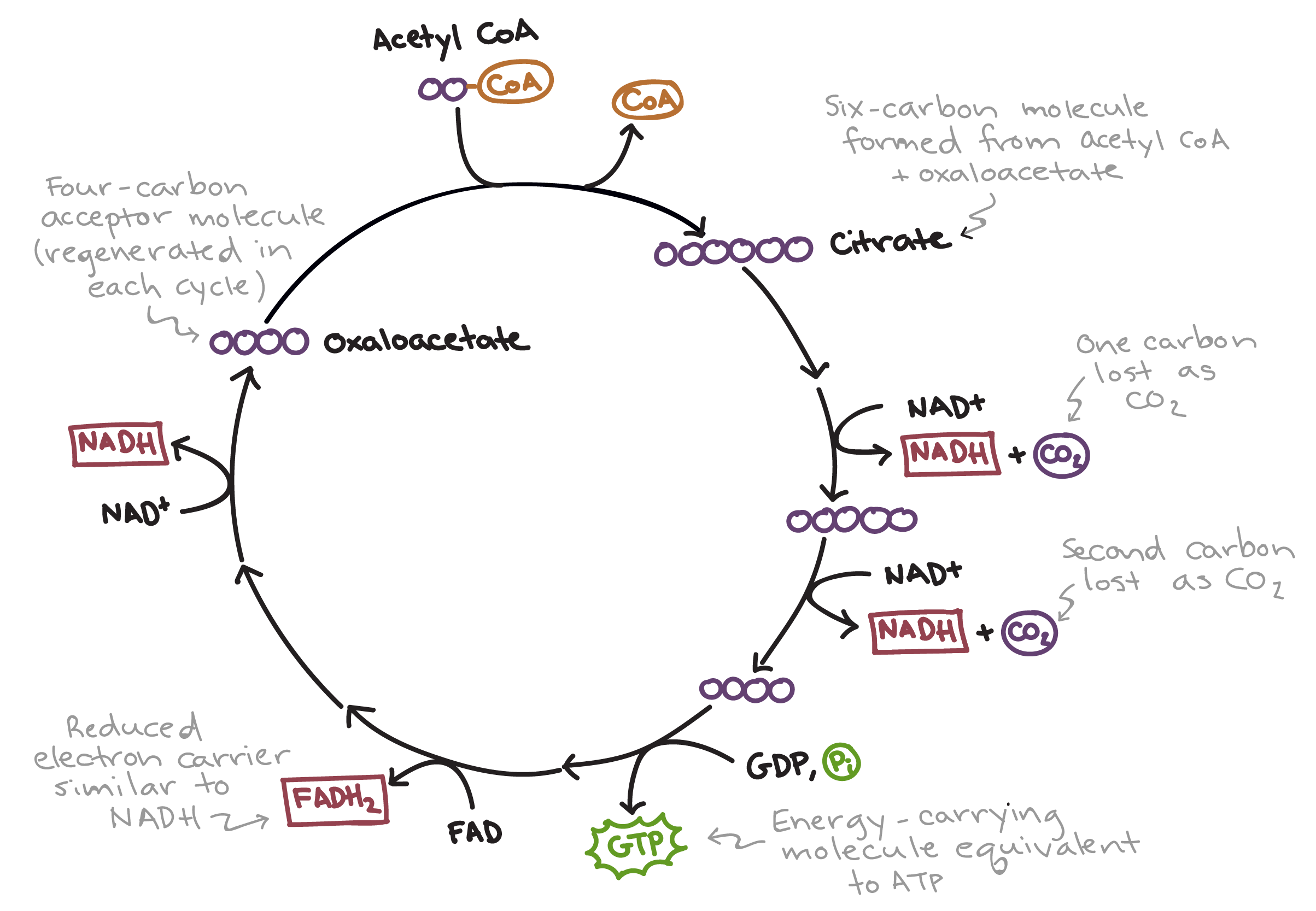
Electron Transport Chain
The transport of electrons begins when NADH donates two electrons and a proton to the electron transport chain, which is passed from one acceptor to the next down an energy gradient until it reaches oxygen. FADH2 also donates its high-energy electrons to the chain, entering at a lower energy level than NADH. As electrons move down the chain, H+ ions are pumped across to the outer compartment of the mitochondrion, which increases the concentration of H+ ions. This process is called the chemiosmotic synthesis of ATP, and 36 ATP molecules are gained from the process.

PROCESS | ATP Produce | ATP Used |
|---|---|---|
Glycolysis | 4 ATP | -2 ATP |
Oxidation of pyruvic acid | -2 ATP | |
Krebs cycle | 2 ATP | |
Electron Transport Chain (3ATP/NADH and 2 ATP/FADH2) 3ATP/NADH (2NADH generated via glycolysis) | 6 ATP | |
From 2 NAHD generated via oxidation of pyruvic acid | 6 ATP | |
From 6 NAHD generated via the Krebs Cycle | 18 ATP | |
From 2 FADH2 generated via the Krebs Cycle | 4 ATP | |
TOTAL | 40 ATP | -4 ATP |
Net ATP | 36 ATP |
ANAEROBIC RESPIRATION - a type of cellular respiration that occurs in the absence of oxygen. This process involves the breakdown of glucose or other organic molecules to produce energy for the cell in the form of ATP. Unlike aerobic respiration, which takes place in the presence of oxygen, anaerobic respiration occurs when oxygen is limited or unavailable, such as in certain bacteria, yeast, and muscle cells.
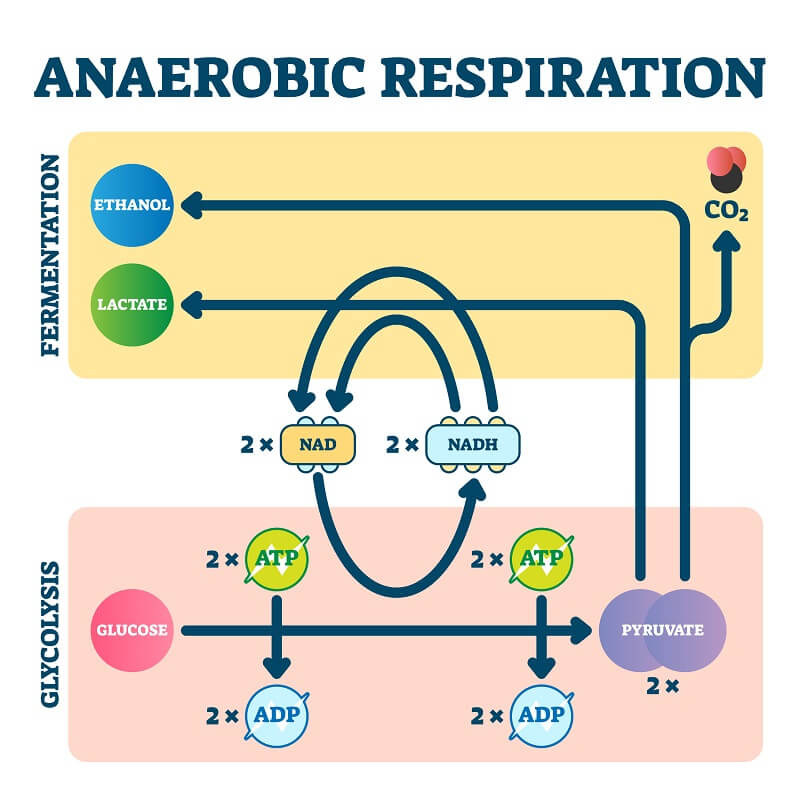
FERMENTATION - the metabolic process in which glucose molecules are converted into acids, gasses, or alcohol in the absence of oxygen or other electron transport chains. For example, by converting sugar into alcohol, yeast performs fermentation to obtain energy. Fermentation is performed by bacteria, converting carbohydrates into lactic acid. The study of fermentation is called zymology
ALCOHOLIC FERMENTATION - The two pyruvate molecules shown in this diagram come from the splitting of glucose through glycolysis. This process also produces 2 molecules of ATP. The continued breakdown of pyruvate produces acetaldehyde, carbon dioxide, and eventually ethanol. Alcoholic fermentation requires the electrons from NADH and results in the generation of NAD+.
Example.: Yeast in bread dough also uses alcoholic fermentation for energy and produces carbon dioxide gas as a waste product. The carbon dioxide that is released causes bubbles in the dough and explains why the dough rises.
LACTIC ACID FERMENTATION - Pyruvic is directly reduced to lactic acid by NADH without the release of CO2.
Lactic acid fermentation is carried out by certain bacteria, including the bacteria in yogurt. It is also carried out by your muscle cells when you work them hard and fast.
DIFFERENCE BETWEEN AEROBIC AND ANAEROBIC
AEROBIC processes in cellular respiration can only occur if oxygen. When a cell needs to release energy, the cytoplasm and mitochondria initiate a chemical exchange that launches the breakdown of glucose. This sugar is carried through the blood and stored in the body as a fast source of energy. The breakdown of glucose into adenosine triphosphate (ATP) releases carbon dioxide (CO2), a byproduct that needs to be removed from the body. In plants, the energy-releasing process of photosynthesis uses CO2 and releases oxygen as its byproduct.
ANAEROBIC processes do not use oxygen, so the pyruvate product — ATP is one kind of pyruvate — remains in place to be broken down or catalyzed by other reactions, such as what occurs in muscle tissue or fermentation. Lactic acid, which builds up in muscles' cells as aerobic processes fail to keep up with energy demands, is a byproduct of an anaerobic process. Such anaerobic breakdowns provide additional energy, but lactic acid build-up reduces a cell's capacity to further process waste; on a large scale in, say, a human body, this leads to fatigue and muscle soreness. Cells recover by breathing in more oxygen and through the circulation of blood, processes that help carry away lactic acid.
Comparison of Photosynthesis and Respiration
Basis of Comparison | Photosynthesis | Respiration |
|---|---|---|
Types of cells where the process occurs | Autotrophic | Autotrophic and Heterotrophic |
Raw Materials | CO2 and H2O | Glucose and Oxygen |
Products | PGAL, monosaccharides, disaccharides, polysaccharides | ATP |
By-Products | O2 and H2O | CO2 and H20 |
Time of the day it occurs | Daytime | Day & Night |
L4: CELLULAR RESPIRATION
Metabolism
It is the process by which the body changes food and drink into energy.

2 Major Parts of Metabolism
ANABOLISM - The part of metabolism that builds up larger molecules, producing new protoplasm or growth. The process by which the body utilizes the energy released by catabolism to synthesize complex molecules. These complex molecules are then utilized to form cellular structures that are formed from small and simple precursors that act as building blocks.

CATABOLISM - The breaking down of complex substances that release energy and the wearing up of cell protoplasm.

Cellular Respiration
The process of oxidizing food molecules like glucose, to carbon dioxide and water.
The process by which organisms combine oxygen with foodstuff molecules, diverting the chemical energy in these substances into life-sustaining activities and discarding, waste products, carbon dioxide, and water.
The term respiration often means breathing or simply “the process of inhaling and exhaling”. For clarity, cellular respiration refers to a series of enzymatic reactions that can occur in the presence or absence of oxygen and make energy available to the cell.

Life depends on energy.
Energy stored in food is converted to other forms of energy, according to the first law of thermodynamics: energy is neither created nor destroyed; it can only transform one form to another.
Energy is conserved and harnessed for cellular activities, while heat is dissipated to increase the random motion of molecules, conforming to the second law of thermodynamics. All objects in the universe tend to become disorderly.
Cells release and convert sugar molecules into ATP, which is used to sustain life by cellular respiration, resulting in a continuous supply of ATP.
2 Types of Cellular Respiration
AEROBIC RESPIRATION - The process of cellular respiration that takes place in the presence of oxygen gas to produce energy from food. In this process, water and carbon dioxide are produced as end products.
It is a biological process in which food glucose is converted into energy in the presence of oxygen.
Glucose (C6H12O6) + Oxygen 6(O2) → Carbon-dioxide 6(CO2) + Water 6 (H2O) + Energy (ATP)
Energy is released by splitting the glucose molecules with the help of oxygen gas. The 2900 kJ of energy is released during the process of breaking the glucose molecule. In turn, this energy is used to produce ATP – Adenosine Triphosphate molecules used by the system for various purposes.
GLYCOLYSIS - the process in which glucose is broken down to produce energy.
It produces two molecules of pyruvate, ATP, NADH, and water. The process occurs in a cell’s cytoplasm and does not require oxygen.
The primary step of cellular respiration, which occurs in all organisms. Glycolysis is followed by the Krebs cycle during aerobic respiration. In the absence of oxygen, the cells make small amounts of ATP as glycolysis is followed by fermentation.

Anaerobic and releases energy from glucose in the cytoplasm of cells, allowing prokaryotes and eukaryotes to transport nutrients from the digestive system.
Glycolysis requires activation energy to begin, and two ATP is needed to start the reaction. The ATP phosphorylates glucose, energizing it to start the reaction. Four ATP and two NADH molecules are generated as a result of the reactions, resulting in a net gain of two ATP.
Glycolysis is the initial step in both aerobic and anaerobic respiration, occurring in the cytoplasmic fluid in an anaerobic condition. It involves the breakdown of glucose into two molecules of pyruvate(pyruvic acid/ three-carbon compound), with a net energy yield of two ATP molecules per glucose molecule. The remaining energy remains in the chemical bonds of pyruvate that must be further broken down.
Steps 1 to 3 - The glucose molecule is energized, using ATP.
Glucose is the first phosphorylated to glucose-6-phosphate (step 1), which is rearranged to form Fructose-6-phosphate (step 2) Another phosphate group is added to form fructose 1,6-diphosphateI (step 3). The cell invests two molecules of ATP in steps 1 and 3 to energize one glucose molecule and form fructose 1,6-bisphosphate, which is unstable and reactive.
Step 4 - Fructose 1,6-diphosphate
Converted into two molecules of glyceraldehyde 3-phosphate (PGAL) Since there are two molecules of PGAL produced, steps 5 to 9 occur twice per glucose molecule
Step 5 - Reduction of PGAL produces NADH This step is the first payoff step. PGAL donates a hydrogen atom and two electrons NAD+ (nicotinamide adenine dinucleotide), reducing it to NADH. NADH, an electron carrier, has a similar structure to NADPH except that it has one less phosphate group attached to ribose
Steps 6 to 9 - ATP and pyruvic acids are produced. A sequence of four chemical reactions completes the breakdown of glucose into two molecules of pyruvic acid. For every molecule of glucose, four molecules of ATPs are formed in steps 6 and 9. Since two molecules of ATP have been invested in the preparatory phase, a net gain of (two) 2 ATP molecules per glucose molecule results from glycolysis.
Oxidation of Pyruvic Acid (the 2nd stage of aerobic respiration)
It occurs in the mitochondrial matrix. In this stage, each molecule of pyruvic acid produced in glycolysis is oxidized while a molecule of NAD+ is reduced to NADH.
A carbon atom is also removed from pyruvic acid and released as CO2, forming a two-carbon molecule called an acetyl group. This acetyl group finally combines with a compound derived from a B vitamin called coenzyme A, forming acetyl-CoA.
Energy is temporarily stored in NADH, and will later be used to convert ADP molecules to ATPs. The two acetyl CoA molecules, on the other hand, will proceed to the third phase of aerobic respiration.
Krebs Cycle
Sir Hand Krebs (1900-1981) German scientist who discovered and studied the workings of the cycle
The Krebs cycle produces two molecules of acetyl-CoA for every glucose molecule oxidized, resulting in 2 ATP molecules, 6 NADH molecules, 2 FADH molecules, and 4 CO2 molecules. This cycle makes two turns for every glucose molecule oxidized, resulting in 2 ATP molecules, 6 NADH molecules, 2 FADH molecules, and 4 CO2 molecules.

Electron Transport Chain
The transport of electrons begins when NADH donates two electrons and a proton to the electron transport chain, which is passed from one acceptor to the next down an energy gradient until it reaches oxygen. FADH2 also donates its high-energy electrons to the chain, entering at a lower energy level than NADH. As electrons move down the chain, H+ ions are pumped across to the outer compartment of the mitochondrion, which increases the concentration of H+ ions. This process is called the chemiosmotic synthesis of ATP, and 36 ATP molecules are gained from the process.

PROCESS | ATP Produce | ATP Used |
|---|---|---|
Glycolysis | 4 ATP | -2 ATP |
Oxidation of pyruvic acid | -2 ATP | |
Krebs cycle | 2 ATP | |
Electron Transport Chain (3ATP/NADH and 2 ATP/FADH2) 3ATP/NADH (2NADH generated via glycolysis) | 6 ATP | |
From 2 NAHD generated via oxidation of pyruvic acid | 6 ATP | |
From 6 NAHD generated via the Krebs Cycle | 18 ATP | |
From 2 FADH2 generated via the Krebs Cycle | 4 ATP | |
TOTAL | 40 ATP | -4 ATP |
Net ATP | 36 ATP |
ANAEROBIC RESPIRATION - a type of cellular respiration that occurs in the absence of oxygen. This process involves the breakdown of glucose or other organic molecules to produce energy for the cell in the form of ATP. Unlike aerobic respiration, which takes place in the presence of oxygen, anaerobic respiration occurs when oxygen is limited or unavailable, such as in certain bacteria, yeast, and muscle cells.

FERMENTATION - the metabolic process in which glucose molecules are converted into acids, gasses, or alcohol in the absence of oxygen or other electron transport chains. For example, by converting sugar into alcohol, yeast performs fermentation to obtain energy. Fermentation is performed by bacteria, converting carbohydrates into lactic acid. The study of fermentation is called zymology
ALCOHOLIC FERMENTATION - The two pyruvate molecules shown in this diagram come from the splitting of glucose through glycolysis. This process also produces 2 molecules of ATP. The continued breakdown of pyruvate produces acetaldehyde, carbon dioxide, and eventually ethanol. Alcoholic fermentation requires the electrons from NADH and results in the generation of NAD+.
Example.: Yeast in bread dough also uses alcoholic fermentation for energy and produces carbon dioxide gas as a waste product. The carbon dioxide that is released causes bubbles in the dough and explains why the dough rises.
LACTIC ACID FERMENTATION - Pyruvic is directly reduced to lactic acid by NADH without the release of CO2.
Lactic acid fermentation is carried out by certain bacteria, including the bacteria in yogurt. It is also carried out by your muscle cells when you work them hard and fast.
DIFFERENCE BETWEEN AEROBIC AND ANAEROBIC
AEROBIC processes in cellular respiration can only occur if oxygen. When a cell needs to release energy, the cytoplasm and mitochondria initiate a chemical exchange that launches the breakdown of glucose. This sugar is carried through the blood and stored in the body as a fast source of energy. The breakdown of glucose into adenosine triphosphate (ATP) releases carbon dioxide (CO2), a byproduct that needs to be removed from the body. In plants, the energy-releasing process of photosynthesis uses CO2 and releases oxygen as its byproduct.
ANAEROBIC processes do not use oxygen, so the pyruvate product — ATP is one kind of pyruvate — remains in place to be broken down or catalyzed by other reactions, such as what occurs in muscle tissue or fermentation. Lactic acid, which builds up in muscles' cells as aerobic processes fail to keep up with energy demands, is a byproduct of an anaerobic process. Such anaerobic breakdowns provide additional energy, but lactic acid build-up reduces a cell's capacity to further process waste; on a large scale in, say, a human body, this leads to fatigue and muscle soreness. Cells recover by breathing in more oxygen and through the circulation of blood, processes that help carry away lactic acid.
Comparison of Photosynthesis and Respiration
Basis of Comparison | Photosynthesis | Respiration |
|---|---|---|
Types of cells where the process occurs | Autotrophic | Autotrophic and Heterotrophic |
Raw Materials | CO2 and H2O | Glucose and Oxygen |
Products | PGAL, monosaccharides, disaccharides, polysaccharides | ATP |
By-Products | O2 and H2O | CO2 and H20 |
Time of the day it occurs | Daytime | Day & Night |
 Knowt
Knowt